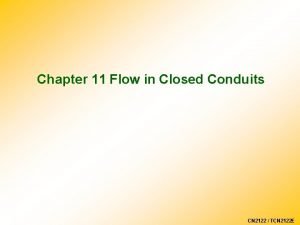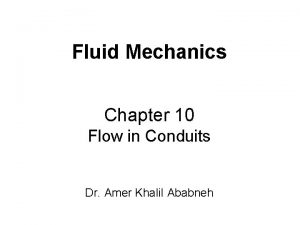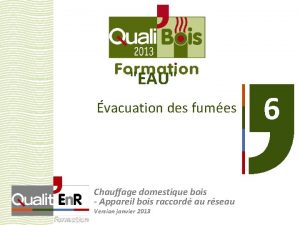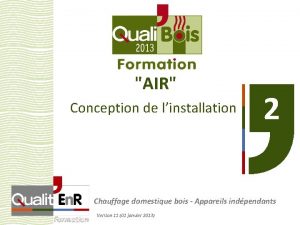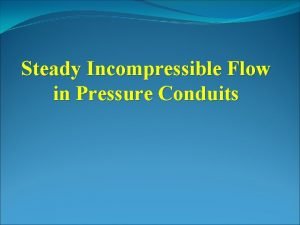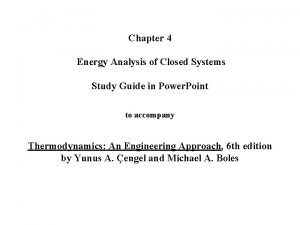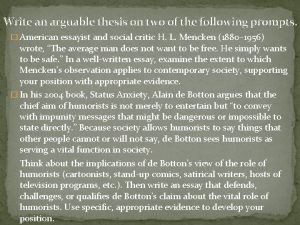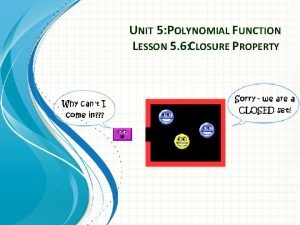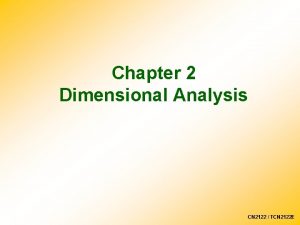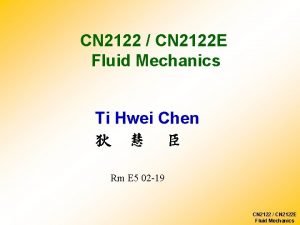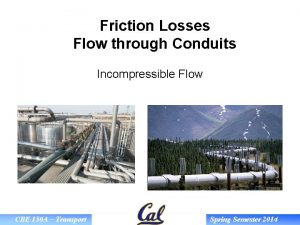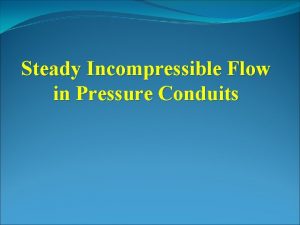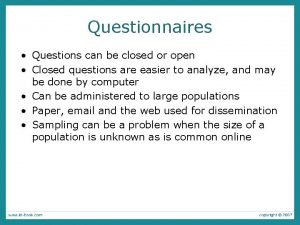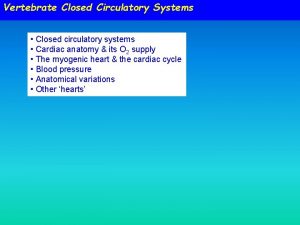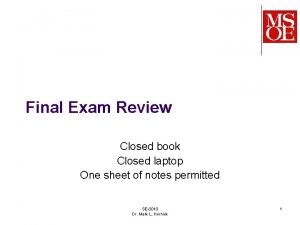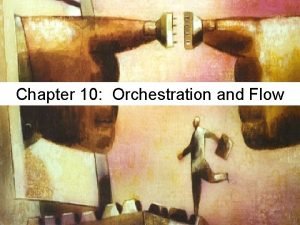Chapter 11 Flow in Closed Conduits CN 2122



























- Slides: 27

Chapter 11 Flow in Closed Conduits CN 2122 / TCN 2122 E

Main Topics ü Introduction ü ü Reynolds' Experiment Dimensional Analysis of Conduit Flow Friction Factor for Fully Developed Laminar Flow Friction Factor for Fully Developed Turbulent Flow • • Smooth Pipe Law Rough Pipe Law Different Workers Results Application Ø Ø Ø • Energy/ pressure loss problem Velocity/ flow rate problem Pipe Sizing Problem Explicit Equation for Friction Factor CN 2122 / TCN 2122 E

Main Topics ü ü ü Equivalent Diameter for Non- Circular Conduit Pressure Drop due to Fittings Loss of Head at Abrupt Enlargement • • • ü Exit Loss of Head at abrupt Contraction Entry Loss Combinations of Pipes CN 2122 / TCN 2122 E

11. 0 Introduction In this chapter, we will go back to consider what we have left out in Chapter 7 - viscous work done term. Because of this, this chapter is quite important for it is dealing with real practical problems. For chemical engineers, more than 90% of their problems involve flows in closed conduits. CN 2122 / TCN 2122 E

11. 1 Reynolds' Experiment The classic Reynolds experiment on viscous flow was conducted in 1883. Water is made to flow through a glass pipe as shown in Fig. 11. 1. 1, the velocity being controlled by an outlet valve. At the inlet of the pipe, a dye having the same specific weight as water is injected into the flow. When the outlet valve is only slightly open, the dye will move through the glass pipe intact, forming a thread as illustrated in Fig. 11. 1. 2. a. The orderly nature of this flow is apparent from this demonstration. However, as the valve is progressively opened, a condition will be reached whereby the dye assumes a fluctuating motion as it proceeds through the pipe. (As depicted in Fig. 11. 1. 2. b. ) A transition is taking place from the previous well ordered flow, which may be considered as laminar flow, to an unstable type of flow. Further opening of the valve then results in a condition whereby irregular fluctuations are developed in the flow so that the thread of dye is completely dispersed before proceeding very far along the pipe. (As shown in Fig. 11. 1. 2. c. ) This irregular flow is called turbulent flow. The experiment brings out the essential difference between laminar and turbulent flow. The former, while having irregular molecular motions, is macroscopically a well ordered flow. However, in the case of turbulent flow, there is the effect of a small but macroscopic fluctuating velocity superimposed on a well ordered flow. Visualization CN 2122 / TCN 2122 E

11. 1 Reynolds' Experiment It was found by Reynolds that the criterion for the transition from laminar to turbulent flow in a pipe is the Reynolds number based on the pipe diameter. In the experiment, the Re was continuously increased by increasing the velocity. However, this could have been accomplished by using pipes of different diameters or using fluids with different viscosities or densities. A Re of approximately 2300 was found to denote the imminence of a transition from laminar to turbulent flow. Under special operating condition, it is found that laminar flow can be maintained for Re up to 40000. All experiments thus far indicated by most workers that below 2300, there can be only laminar flow. (However, Bird et al gives a value of 2100, to be on a safer side, we will take 2100 as the criterion. ) Thus after 2100 has been reached, there may be a transition depending on the extent of local disturbances. We called this value (2100) of Re the critical Re. CN 2122 / TCN 2122 E

11. 2 Dimensional Analysis of Conduit Flow To consider the flow of fluid in a straight and horizontal circular pipe of constant cross section, we do not have to worry about the surface tension, because there is no free surface; there is no need to consider gravity, because the pipe is placed on an horizontal plane. We only have to consider the diameter of the pipe (D), the velocity of the flow (v), the density of the fluid (ρ), the pressure drop across the pipe (-gcΔP), the viscosity of the fluid (μ), the roughness of the pipe (e) and the length of the pipe (L). Dimensional Matrix can be set up. D v ρ - gcΔP μ e L M 0 0 1 1 1 0 0 L 1 1 -3 -1 -1 1 1 θ 0 -1 0 -2 -1 0 0 All together, there are seven parameters involved and the rank of the above dimensional matrix is 3, so according to the Buckingham's π theorem, there shall be four dimensionless groups. π1 = f (π2, π3, π4) (11. 2. 1) where π1 = Da vb ρc (-gcΔP) = Mc + 1 La + b - 3 c - 1 t- b - 2 = D 0 v-2 ρ-1 (-gcΔP) = Eu π2 = Da vb ρc μ = Mc + 1 La + b - 3 c - 1 t- b - 1 = D-1 v-1 ρ-1 μ = 1/Re π3 = Da vb ρc e = Mc La + b - 3 c + 1 t-b = D-1 v 0 ρ0 e = e / D π4 = Da vb ρc L = Mc La + b - 3 c + 1 t-b = D-1 v 0 ρ0 L = L / D CN 2122 / TCN 2122 E

11. 2 Dimensional Analysis of Conduit Flow Therefore, (11. 2. 2) This is a rather complicated relation, fortunately, from experimental fact done by previous workers, it is known that the Eu is directly proportional to L / D, (that is when a pipe is longer, the pressure drop will be larger, when a pipe size is reduced, the pressure drop will also become larger), so this term can be isolated from the rest, and (eq. 11. 2. 2) becomes, Eu = L / D f' (Re, e / D) (11. 2. 3) The function f' (Re, e / D), is a dimensionless expression, which is designated as friction factor φ. There are many kinds of definition for φ, such as Fanning friction factor: Eu = 2 φf (L / D) (11. 2. 4) Darcy friction factor: Eu = φD / 2 (L / D) (11. 2. 5) Ti friction factor: Eu = φT (L / D) (11. 2. 6) It can be observed to find that φD = 2 φT = 4 φf There might be other forms of φ, but the two introduced are the most popular. In this course, Fanning friction factor will be used extensively. CN 2122 / TCN 2122 E

11. 2 Dimensional Analysis of Conduit Flow Please be noted that although the Euler’s expression (eqn 11. 2. 4 - 11. 2. 6) gives the relationship of pressure drop to the friction, but the pressure drop here is considered to be the cause of the flow and it is to compensate the energy loss in the system. In fact energy loss can be considered as pressure drop, heat transfer, viscous work done or internal energy change. Energy loss in the system may accompany temperature change of the fluid, and the temperature change may give rise to a heat transfer and the energy loss will give viscous work done to the surrounding. If all three terms have to be considered then it may become messy, so it will be easier if the energy loss is to lump into a single term. In the following working, energy loss is considered to be in the viscous work done term only and the other term, namely, heat transfer and internal energy change have been considered to be zero. CN 2122 / TCN 2122 E

11. 3 Friction Factor for Fully Developed Laminar Flow Since friction factor related to Euler number Eu, and this is to the pressure drop. We recall the relation of the pressure drop with the velocity of fully developed laminar incompressible flow. The Hagen Poiseuille equation, (i. e. eq. 9. 1. 7), (9. 1. 7) After integrating, we will have (11. 3. 1) Make the left hand side of the above equation to become Eu From (eq. 11. 2. 4), it is known that for fully developed laminar flow in closed conduit, the Fanning friction factor related with Re in the following form, (11. 3. 2) CN 2122 / TCN 2122 E

11. 4 Friction Factor for Fully Developed Turbulent Flow From eqs. (11. 2. 4) to (11. 2. 6), it is already noticed that friction factor is a function of Reynolds number and relative roughness. By experimental experiences, it is known that when Re is low, φ is merely a function of Re, when Re is very high, then φ is a function of (e / D). This characteristic has already been proven partially in the laminar flow region, φ is indeed a function of Re only. When the flow velocity is high enough to be beyond the laminar flow region, but not too high, it is found that φ agrees to Smooth Pipe law, when the flow velocity is very high, then φ agrees to Rough Pipe law. 11. 4. 1 Smooth Pipe Law: This law states that the transmission factor (that is the reciprocal of the square root of friction factor depends on the Reynolds number Re only. That is to say that for the laminar sublayer, the locus of all viscous effects, is decreasing in size as the Reynolds number increases, allowing more of the conduit cross section to flow in a turbulent condition, but that flow is still unaffected by the conduit wall. It will have the following form (11. 4. 1. 1) CN 2122 / TCN 2122 E

11. 4 Friction Factor for Fully Developed Turbulent Flow 11. 4. 2 Rough Pipe Law: It states that the transmission factor depends only on the cross sectional area of flow, i. e. it is a function of the ratio of diameter to wall roughness, and is independent of fluid properties. This implies that over here the laminar sublayer has shrunk to the point where it is no longer a continuum, and surface texture now protrudes into the turbulent core (which in effect fills the entire pipe) and affects the nature of the flow. The rough pipe law thus defines the limiting value of the transmission factor as flow rate continues to increase. It has the following form, (11. 4. 2. 1) (The reason for having the smooth pipe law and rough pipe law can be thought to be due to the boundary layer thickness. When Re is small, the boundary layer thickness is thick and the roughness of the pipe is within the layer. When Re is high, then the thickness of Boundary layer is thin, and the roughness of pipe becomes protruding above the Boundary layer. ) CN 2122 / TCN 2122 E

11. 4 Friction Factor for Fully Developed Turbulent Flow 11. 4. 3 Different Workers Results: In 1932, Nikuradse was the first to carry out experimental works by painstakingly gluing sands on the pipe wall, according to his results, the coefficients in Smooth pipe law (SPL) & Rough pipe law (RPL), A, B, C, E are 4. 0, -0. 40, 4. 0 & 2. 28 respectively. In 1956, Smith and his coworkers redid Nikuradse's experimental and their work seems to work very well, their coefficients A, B, C, E are, 4. 06, -0. 60, 4. 0 & 2. 273 respectively, which are very closed to Nikuradse's work. However, it is believe that Ti's coefficients are the best, which are simply the average of the two. So A, B, C, E are 4. 03, -0. 50, 4. 0 & 2. 2765. A B C E Coefficients for SPL & RPL Nikuradse Smith 4. 06 -0. 40 -0. 60 4. 0 2. 28 2. 273 Ti 4. 03 -0. 50 4. 0 2. 2765 CN 2122 / TCN 2122 E

11. 4 Friction Factor for Fully Developed Turbulent Flow It is known that as the flow increases, the friction factor φ will relate according to SPL and RPL. There must be a transitional region exists between SPL & RPL, Colebrook in 1939, proposed an equation for this transition zone which actually combine the SPL & RPL into one equation. (11. 4. 3. 1) Which becomes asymptotic to the SPL at low Re, and asymptotic to RPL at high Re. This was the first reasonably successful attempt to define a universal φ relationship for turbulent flow. Up to now, we know that when the flow is laminar the φ relates Re according to (eq. 11. 3. 2), when the Re increases to turbulent then we can use eqs. (11. 4. 1. 1), (11. 4. 2. 1) or (11. 4. 3. 1). But using these equations may involve trial and error, fortunately, in 1944 Moody based on Colebrook's equation developed a correlation which has become an engineering design standard. The Moody diagram is used far and wide in fluid mechanics work and piping system specification, for which the correlation is generally valid and accurate. However, when numerical computation is required (via computer), then eqs. (11. 3. 2) & (11. 4. 3. 1) can be used for laminar and turbulent flow respectively. Care must be taken at the transitional region, as the friction factor is not continuous in this region. CN 2122 / TCN 2122 E

11. 4 Friction Factor for Fully Developed Turbulent Flow 11. 4. 4 Application: It may be classified to have three types of pipe flow problems that occur in engineering practice, they are listed as follow: 1. The pressure drop problem: Given pipe diameter (D), length (L), surface roughness (e), fluid properties (ρ, μ), and velocity (v) or flow rate (Q), find the pressure drop (-ΔP). 2. The velocity/flow rate problem: Given pipe diameter, length, roughness, fluid properties, and pressure drop, find the resulting velocity or flow rate. 3. The pipe sizing problem: Given pipe length and roughness, fluid properties, pressure drop, and velocity or flow rate (but not both), select an appropriate pipe diameter. Example 11. 4. 4. 1 Example 11. 4. 4. 2 Example 11. 4. 4. 3 Design example CN 2122 / TCN 2122 E

11. 4 Friction Factor for Fully Developed Turbulent Flow 11. 4. 5 Explicit Equation for Friction Factor: Colebrook equation has received wide acceptance, probably because it was used by Moody (1944) in the preparation of his friction factor charts. However, Colebrook's equation is implicit in Fanning's friction factor, φf, and must therefore be solved by iteration, a formidable task in 1944 when Moody presented his charts which, no doubt, accounts for their popularity. Solution of Colebrook's equation by numerical methods to any desired degree of precision is accomplished easily, quickly and cheaply with today's digital computers. Even then, an explicit equation for friction factor is still preferred at any time. In 1979, N. H. Chen proposed the following explicit equation, which is reckoned to be the best. It has the following form, With the Chen's equation, we may obtain the friction factor explicitly. Examples Tables 11. 4. 1 and 11. 4. 2 CN 2122 / TCN 2122 E

11. 5 Equivalent Diameter for Non- Circular Conduit For laminar flow in different cases (eg. in flat walls, pipes, annular conduit and inclined plane), we have already introduced. Since Moody diagram can only work for circular pipe, so we can not solve for the turbulent flow in many non- circular conduits unless, the diameter D used in the Moody diagram is replaced by the equivalent diameter Deq defined by the following relation, Deq = 4 r. H (11. 5. 1) In this equation, r. H is the hydraulic radius, which is defined by the following equation, Where A is the cross sectional area of the conduit, and lp is the wetted perimeter of the conduit. For the flow of a gas, lp will always be the length of wall that is actually in contact with the fluid. ; for liquids, however, it will be somewhat less than the periphery if the liquid has a free surface and incompletely fills the total cross section, it will then be the wetted length, the free surface length will be excluded. The use of equivalent diameter is to provide a means for non-circular conduit to use Moody diagram to evaluate the friction factor term. That is to find the Reynolds Number and the relative roughness. When flow rate is involved, one should use the actual cross section area. CN 2122 / TCN 2122 E

11. 6 Pressure Drop due to Fittings The pressure drop (or energy loss) caused by friction in a pipe calculated from eqs. (11. 2. 4) or (11. 2. 5) is only a part of the total energy dissipation which must be overcome in pipe lines and other fluid flow conduits. Other losses may occur due to the presence of valves, elbow and other fittings that involve a change in the direction of flow or in the size of the flow passage. The energy dissipation caused by bends, elbows, joints, valves and other disturbing elements are frequently referred to as ‘minor losses’. However, they can often be more significant in a piping system than the losses due to wall friction. The total energy loss is consisted of major and minor loss, where major loss is due to the friction of the pipe wall, and minor loss is due to the pipe fitting. Major loss: Minor loss: Alternatively, with equivalent length approach CN 2122 / TCN 2122 E

11. 6 Pressure Drop due to Fittings Table 11. 6. 1 Figure 11. 6. 1 CN 2122 / TCN 2122 E

11. 7 Loss of Head at Abrupt Enlargement One ‘minor loss’ which can be subjected to analysis is that at an abrupt enlargement of the cross section, such as that illustrated in Fig. 11. 7. 1. Derivation of (eq. 11. 7. 6) 11. 7. 1 Exit Loss: If A 2 approaches to ∞ , then (eq. 11. 7. 6) shows that the loss at an abrupt enlargement tends to (v 12 / 2 ). This happens at the outlet of a submerged pipe discharging into a large reservoir. In such circumstances the loss is usually termed the exit loss for the pipe. The loss coefficient for exit loss is thus equal to one. 11. 7. 2 Loss of Head at abrupt Contraction: Although an abrupt contraction is geometrically the reverse of an abrupt enlargement, it is not possible to apply the momentum equation to a control volume between sections 1 & 2. This is because, just upstream of the junction, the curvature of the stream lines and the acceleration of the fluid cause the pressure at the annular face to vary in an unknown way. However, immediately downstream of the junction a vena contracta is formed, after which the stream widens again to fill the pipe. Eddies are formed between the vena contracta and the wall of the pipe, and it is these which cause practically all the dissipation of energy. CN 2122 / TCN 2122 E

11. 7 Loss of Head at Abrupt Enlargement Between the vena contracta and the downstream section 2, where the velocity has again become sensibly uniformed - the flow pattern is similar to that after an abrupt enlargement, and so the loss of head is assumed to be given by the similar form of (eq. 11. 7. 6). (11. 7. 2. 1) Where Ac represents the cross sectional area of the vena contracta, although the area A 1 is not involved in (eq. 11. 7. 2. 1) explicitly, the value Ac depends on the ratio of A 2 / A 1. 11. 7. 3 Entry Loss: As A 1 approaches ∞ , the value of K tends to 0. 5 (by experiment), and this limiting case corresponds to the flow from a large reservoir into a sharp edged pipe, as in Fig. 11. 7. 3. 1. If the pipe is protruded into the reservoir, then it will cause a greater loss of head, as in Fig. 11. 7. 3. 2. For a non protruding sharp edged pipe the loss 0. 5 (v 22 / 2 ) is known as the entry loss. If the inlet to the pipe is well rounded, as in Fig. 11. 7. 3. 3, the fluid can follow the boundary without separating from it, and the entry loss can be taken as zero. CN 2122 / TCN 2122 E

11. 8 Combinations of Pipes can be connected in series (i. e. end to end) or in parallel (i. e. sharing the same ends), no matter which kinds of combinations we are having, they all follow Kirchhoff's two laws. Kirchhoff's first law: Through a node, those entering must equal to those leaving. Kirchhoff's second law: For a closed loop, the pressure drop of this loop is zero. (Since that becomes taking the pressure drop at the same point. ) Applying the two Kirchhoff's laws, not only we can solve the simple pipes in series or in parallel problem, but we can also solve a very complicated network as well. For branches connected in series, the flow rate through them will be the same but the pressure drop across them will be the sum of the pressure drop across each branch. For branches connect in parallel, the pressure drop across them will be same as the pressure drop across each individual branch, the flow rate through them will be the sum of the flow through each individual branch. CN 2122 / TCN 2122 E

Points to remember ü The energy loss in the system can be considered to be contributed by the heat transfer, viscous work done, internal energy change, (or even a pressure change). However, it will be troublesome if we have to consider the individual contribution separately. It is more convenient to lump all the losses into one single term and putting the rest to zero. I make use of the viscous work done term, but you have the freedom to consider in whichever term you prefer. ü The term, head is just expressing the energy in the dimension of length. We can have potential head, pressure head or kinetic head. So head loss is another term for energy loss. ü Chen’s equation can be used in substitution for the Moody diagram. It has the same characteristics as the Moody diagram. ü For non-circular conduit, we use its equivalent diameter to find the Reynolds number as well as the relative roughness. (The reason for coming up with the equivalent diameter is to ensure that we can make use of the Moody diagram. ) CN 2122 / TCN 2122 E

Points to remember ü Two ways to consider minor loss, they are the equivalent length and the loss coefficient ü When we have a pipeline network, for branches connected in series, the flow rate through them will be the same but the pressure drop across them will be the sum of the pressure drop across each branch. For branches connect in parallel, the pressure drop across them will be same as the pressure drop across each individual branch, the flow rate through them will be the sum of the flow through each individual branch. CN 2122 / TCN 2122 E

MODULE LEARNING OUTCOME (for CN 2122) On successful completion of this module, the student will be able to: • Apply dimensional analysis to obtain dimensionless groups for the physical phenomenon, and model theory to predict the behaviour of a system from its dynamically similar system • Explain and find the pressure in static fluids • Apply finite and differential control volume approach of the continuity, momentum and energy equations to solve various fluid flow problems • Describe the concept of inviscid flow and stream function • Examine viscous flow in momentum boundary layer around an immersed object • Perform calculation for a centrifugal pump in a piping system • Describe the effect of operating variables on packed bed and fluidized bed operations CN 2122 / TCN 2122 E

MODULE LEARNING OUTCOME (for TCN 2122) On successful completion of this module, the student will be able to: • Apply dimensional analysis to obtain dimensionless groups for the physical phenomenon, and model theory to predict the behaviour of a system from its dynamically similar system • Explain and find the pressure in static fluids • Apply finite and differential control volume approach of the continuity, momentum and energy equations to solve various fluid flow problems • Describe the concept of inviscid flow and stream function • Examine viscous flow in momentum boundary layer around an immersed object • Perform calculation for a centrifugal pump in a piping system • Work in a team to design and conduct experiments with consideration of safety and environmental impact, collect and analyse data and write technical report. CN 2122 / TCN 2122 E

Tutorial Link to Tutorial 7 CN 2122 / TCN 2122 E
 Flow in closed conduits example
Flow in closed conduits example Fy 2122
Fy 2122 Total head formula
Total head formula Choix chauffage
Choix chauffage Dimensionnement des conduits de fumées
Dimensionnement des conduits de fumées In pressure conduits
In pressure conduits Conduits herz
Conduits herz Normally open timed open symbol
Normally open timed open symbol Chapter 4 energy analysis of closed systems
Chapter 4 energy analysis of closed systems Absorption atelectasis
Absorption atelectasis T piece
T piece Non rebreather mask definition
Non rebreather mask definition What is turbulent flow
What is turbulent flow External flow
External flow Energy naturally flows from warmer matter to cooler matter
Energy naturally flows from warmer matter to cooler matter Oikos meaning
Oikos meaning Transform flow and transaction flow
Transform flow and transaction flow Data flow structure
Data flow structure Examples of rotational and irrotational flow
Examples of rotational and irrotational flow Internal flow examples
Internal flow examples Data flow vs control flow
Data flow vs control flow Cheese processing flow chart
Cheese processing flow chart Control flow and data flow computers
Control flow and data flow computers Transaction flow graph
Transaction flow graph What is a closed thesis statement
What is a closed thesis statement Closed thesis statement
Closed thesis statement Is php closed source
Is php closed source Closure property of polynomials
Closure property of polynomials
